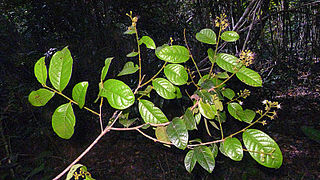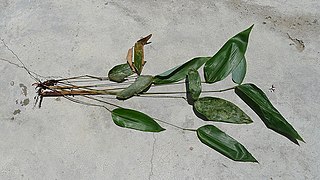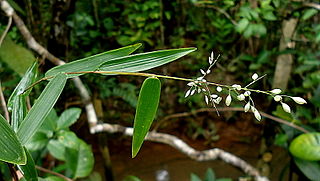
Ditaxis is a plant genus of the family Euphorbiaceae first described as a genus in 1824. Its name comes from Greek dis ("two") and taxis ("rank"), referring to the stamens which are in two whorls. The genus is widespread across much of the Western Hemisphere from the southern United States to Uruguay.

Dalechampia is a genus of plant of the family Euphorbiaceae and of the monogeneric subtribe Dalechampiinae. It is widespread across lowland tropical areas primarily in the Americas with smaller numbers of species in Africa, Madagascar, and southern Asia. Additional new species are still being described and several are very rare and at risk of extinction.

Vriesea is a genus of flowering plants in the botanical family Bromeliaceae, subfamily Tillandsioideae. The genus name is for Willem Hendrik de Vriese, Dutch botanist, physician (1806–1862). Its species are widespread over Mexico, Central America, South America and the West Indies.

Campomanesia is a genus in the family Myrtaceae described as a genus in 1794. It is native to South America and Trinidad.

Hirtella is a genus of 110 species of woody trees in family Chrysobalanaceae. It was first described as a genus by Linnaeus in 1753. Hirtella naturally occurs in tropical forests throughout Latin America, the West Indies, southeast Africa, and Madagascar. The flowers are mainly pollinated by butterflies.

Renealmia is a plant genus in the family Zingiberaceae. Its members are native to tropical Africa and tropical America. In Peru, fruits and tubers are sources of indigenous dyes. and indigenous medical treatments for leishmania and malaria In Colombia, it is used to treat snakebite. Bracts and leaves can serve as phytotelmata, retaining small quantities of water that offer habitat for other organisms.

Piresia is a genus of South American plants in the grass family.
- Piresia goeldiiSwallen - French Guiana, Suriname, Venezuela (Amazonas), Colombia (Amazonas), Ecuador, Peru (Loreto), Brazil
- Piresia leptophyllaSoderstr. - Colombia (Amazonas), Ecuador, Peru, Brazil(Pernambuco, Amazonas, Bahia), Trinidad & Tobago
- Piresia macrophyllaSoderstr. - French Guiana, Peru, Brazil
- Piresia palmulaM.L.S.Carvalho & R.P.Oliveira - Brazil (Bahia)
- Piresia sympodica(Döll) Swallen - Venezuela, French Guiana, Suriname, Guyana, Colombia, Ecuador, Peru, Brazil, Trinidad & Tobago
Raddiella is a genus of Neotropical plants in the grass family native to South America, Panama and Trinidad.
- Raddiella esenbeckii(Steud.) C.E.Calderón ex Soderstr. - Brazil, Bolivia, Colombia, Venezuela, French Guiana, Suriname, Guyana, Trinidad, Panama
- Raddiella kaieteuranaSoderstr. - Venezuela (Bolívar), Suriname, Guyana, Brazil (Pará)
- Raddiella lunataZuloaga & Judz. - Rondônia, Mato Grosso
- Raddiella malmeana(Ekman) Swallen - Pará, Mato Grosso
- Raddiella minimaJudz. & Zuloaga - Pará, Mato Grosso
- Raddiella molliculma(Swallen) C.E.Calderón ex Soderstr. - Caquetá
- Raddiella potaroensisSoderstr. - Venezuela (Bolívar), Guyana
- Raddiella vanessiaeJudz. - French Guiana
Reitzia is a genus of plants in the grass family.

Luziola (watergrass) is a genus of New World in the grass family, native to North and South America including the West Indies.
Cryptochloa is a genus of Neotropical plants in the grass family, widespread across much of Mexico, Central America, and South America.
- Cryptochloa capillata(Trin.) Soderstr. - French Guiana, Brazil
- Cryptochloa concinna(Hook.f.) Swallen - Colombia, Central America, southern Mexico
- Cryptochloa decumbensSoderstr. & Zuloaga - Panama
- Cryptochloa dressleriSoderstr. - Panama
- Cryptochloa soderstromiiDavidse - Panama
- Cryptochloa strictiflora(E.Fourn.) Swallen - Central America, southern Mexico, Ecuador
- Cryptochloa unispiculataSoderstr. - Bolivia, Peru, Ecuador, Colombia, Brazil (Acre)
- Cryptochloa varianaSwallen - Honduras, Panama, Colombia
Streptostachys is a genus of South American plants in the grass family.

Sucrea is a genus of Brazilian plants in the grass family.
- Sucrea maculataSoderstr. - Rio de Janeiro, Espírito Santo
- Sucrea monophyllaSoderstr. - Bahia
- †Sucrea sampaiana(Hitchc.) Soderstr. - Espírito Santo†
Diandrolyra is a genus of Brazilian plants in the grass family.
- Diandrolyra bicolorStapf - Espírito Santo
- Diandrolyra pygmaeaSoderstr. & Zuloaga ex R.P.Oliveira & L.G.Clark - Bahia
- Diandrolyra tatianaeSoderstr. & Zuloaga - São Paulo, Bahia, Rio de Janeiro, Espírito Santo

Olyra is a genus of tropical bamboos in the grass family. It is native primarily to the Western Hemisphere, with one species extending into Africa.

Parodiolyra is a genus of Neotropical plants in the grass family.
- Parodiolyra aratitiyopensisJ.R.Grande - Venezuela (Amazonas)
- Parodiolyra colombiensisDavidse & Zuloaga - Colombia (Caquetá)
- Parodiolyra lateralis(J.Presl ex Nees) Soderstr. & Zuloaga - Nicaragua, Costa Rica, Panama, Colombia, Venezuela, Guyana, Suriname, Ecuador, Peru, Brazil
- Parodiolyra luetzelburgii(Pilg.) Soderstr. & Zuloaga - Brazil, Colombia, Venezuela, Guyana, Suriname, French Guiana
- Parodiolyra micrantha(Kunth) Davidse & Zuloaga - Brazil, Colombia, Venezuela, Guyana, Suriname, French Guiana, Peru, Bolivia, Argentina, Paraguay
- Parodiolyra ramosissima(Trin.) Soderstr. & Zuloaga - Brazil (Bahia)

Homolepis is a genus of Neotropical plants in the grass family. They are native to Mexico, Central and South America, and the West Indies.

Barbacenia is a plant genus in the family Velloziaceae, described as a genus in 1788. The entire genus is endemic to Brazil with the exception of B. celiae, which crosses the border into Venezuela.
Eremitis is a genus of bamboo plants in the grass family, that is endemic to Brazil.

Schwartzia is a genus of flowering plants belonging to the family Marcgraviaceae. It is found in tropical parts of South America, mainly within the rainforest. It has greenish, white, reddish or red coloured flowers.














